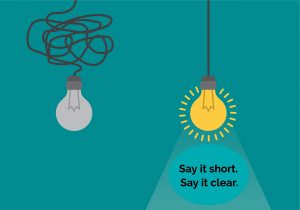Say it short, say it clear – why concise communication is so important and the four pieces of short content that every business needs.
I once sat in a meeting with someone who talked for half an hour, at the end of which I still didn’t understand what his business did, what he wanted from me (he’d asked for the meeting) and/or what he was offering me.
My initial reaction was that I should ask more questions until I did understand. Then I realised that all the time in the world wasn’t going to make any difference. If he couldn’t explain it in half an hour, he probably couldn’t explain it in an hour, three hours, eight hours.
Whereas if he had had a clear and compelling value proposition, he would have communicated the essence of it in no more than a few seconds, and the remainder of the meeting would have seen me engaged and wanting to know more.
Communicating ideas concisely is not easy. French mathematician and physicist Blaise Pascale is famously attributed with telling a correspondent; “If I had more time, I would have written you a shorter letter.” What Pascale understood was that shortest forms of communication are the hardest to perfect.
In that sense a 21st century business communication is no different to a 17th century letter. But short forms are essential and there are three reasons it’s worth putting in the time and effort.
- Shaping our thinking – the very process of creating these short forms, working out what is important and what to leave out, helps us to determine what is the heart of our value proposition.
- Opening up opportunities – unlike my meeting companion, we’re not usually going to get half an hour to explain ourselves. We tend to get a much shorter time to engage, but if we can do it well, we open up opportunity.
- Basis for all longer forms – getting our core message nailed down creates a foundation for longer forms of communication, ensuring that they are always clear and consistent.
Ok, so that’s why you need short form communication, but what exactly do you need?
For my money, there are four basics that every business needs:
1. Elevator pitch
Possibly the single most important pieces of content you can ever have, whether you are a solopreneur or an account manager for a multinational. An elevator pitch is a 10-15 second answer to the question ‘what do you do?’. That question is an opportunity window opening, and the words that come out of your mouth in the following 10 seconds are the difference between that window slamming shut or opening wider.
Even if you think that the person you’re speaking to is not a potential client – you never know. See my ‘true story’ post on LinkedIn for proof!
Good elevators pitches take thought, work and practice. Getting a message right in 10 seconds is hard. What you leave out is just as important as what you put in, and they must focus on who and how you help.
2. 1-minute pitch
The big brother of the elevator pitch. The sole aim of the elevator pitch is to get the person to engage further. So the one-minute pitch is the answer you give when they say ‘that’s interesting, tell me more…’. It is also the pitch you give to introduce yourself in a meeting, if you’re on a panel, or at a networking group.
3. Positioning statement
A written equivalent of the one-minute pitch – it’s what you use when you need to introduce yourself/your business in written format. That is often an email, but could be a paragraph in an executive summary (but not the opening paragraph, please!) or the home/about page on your website. It can be adapted to become your LinkedIn profile. With a few tweaks, you can use it for conference brochures or award nominations. It is usually 100-300 words and focuses on who you help, the problem you solve and the solutions you provide.
4. Company presentation
This is the overview presentation you give to a new client, partner or supplier. It will include identifying your audience, their issue, the outcomes you’ll give them, the solution you offer and stories of customers where you have done this before. You’ll develop it with a clear plan for what you want your audience to think, know and do once they’ve heard it. It will have a strong opening and close and tells a narrative to engage the audience. In its short form, it will be a 5 to 10-minute presentation, but if structured smartly, can be easily expanded with more detail to become a 20min, 40min or one-hour version.
It’s worth spending some time on creating these four short-form building blocks. They’ll help focus your thinking, open opportunity and make creating your bigger pieces of content more straightforward.
And they’ll mean you’ll never spend half an hour talking only to find a blank face looking back at you.
Carol Benton is a message strategist and business writer, who helps technology companies to communicate more effectively. Check out how Words2Win can help you with your message strategy and content. For hints and tips on creating the perfect presentation, request a copy of the Words2Win eBook ‘Preparing the perfect presentation’.
Don’t have the time/confidence to create the content yourself? Words2Win will develop a ‘Short form basics pack’ for you. Get in touch to talk it through.

